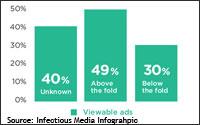54% Of Digital Ads Aren't Viewable, And Even 'Viewability' Is In A Black Box
- by Tyler Loechner @mp_tyler, October 30, 2013
 More data has come out today
that suggests roughly half -- or in this case 54% -- of digital ads aren't even viewable.
More data has come out today
that suggests roughly half -- or in this case 54% -- of digital ads aren't even viewable.
Ad impressions that are above the fold are viewable 49% of the time. Below-the-fold impressions become viewable just 30% of the time.
Highlighting the digital advertising industry's transparency concerns is the data that marketers don't know whether or not a full 40% of their viewable ads were placed above or below the fold. The fact that marketers don't know where nearly half of their viewable ads are initially placed is important because viewability metrics are often one benchmark of success for a campaign.
The data comes from Infectious Media, a company founded in 2008 that specializes in real-time advertising. They defined "viewable" in their infographic the same way IAB does: at least half of the ad must be in view for a minimum of one second.
The infographic also says that campaign performance is tied more closely to exposure (how long the ad was viewable) than frequency.
There
are some companies that track the difference between "viewable" and "seen." Essentially, just because an impression was viewable doesn't mean it was seen. Recent data suggests the actual seen rate of online ads is closer to 14%.
Editor's note: The initial version of this article incorrectly attributed the 54% figure to Infectious Media. That particular figure came from comScore's vCE Benchmarks study from June 2013.



Tyler, Is this 54% a pre-fraud figure or a post-fraud figure? Because if it's post-fraud, and the fraud factor is 60% (as suggested in several MediaPost articles), that means only 32.4% of the ads exposed to real humans aren't viewable (not the inflammatory 54% you cite here). As ersatz plumber Curley Howard observed 75 years ago when unwittingly mistaking an electrical conduit for a water pipe: "No wonder the water doesn't work. The pipes are clogged with wires!" And they called them stooges. Go figure.
Oops, I mean't to say only 21.6% aren't viewable (54% of 40%). Like I said, the pipes are clogged with wires, including mine!
Hey Mike,
Glad you asked the question, cause it caused me to reach out and find out the 54% figure is actually from a comScore report earlier in the year (added a note to the article) ..... Not sure the fraud factor would change the viewability numbers, would it?
My thinking: If every 100 times a page loads, and your ad is in-view 50% of the time, that proportion wouldn't change just because a human was the one behind the screen 40 of those 100 times. But I'm looking in to it to try to find out for sure...
I'd love to see this methodology applied to magazines.
This method is applied to magazines if you look carefully at the studies of the sections of a magazine that are read, percentages thereof, etc... Not many people spend the time/energy required to do it. But here's an important thing to note: If online ads were very effective, the economics would be far better for the online content people. but the economics are miserable. Online advertising is dirt cheap - indicating that there's some huge gap somewhere. Perhaps it's this true impact question that issues like viewability & fraud are getting at.
Right you are, Doug. Network prime time CPMs of $50 vs. Facebook CPMs of ten cents to theoretically "reach" the same people. That dime price is only sustainable because Facebook has so much inventory and no programming costs to speak of. But make no mistake, we're talking about the exact same audience.